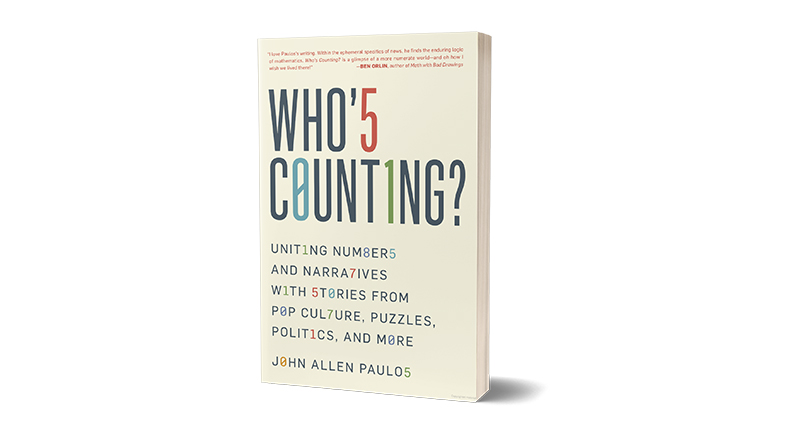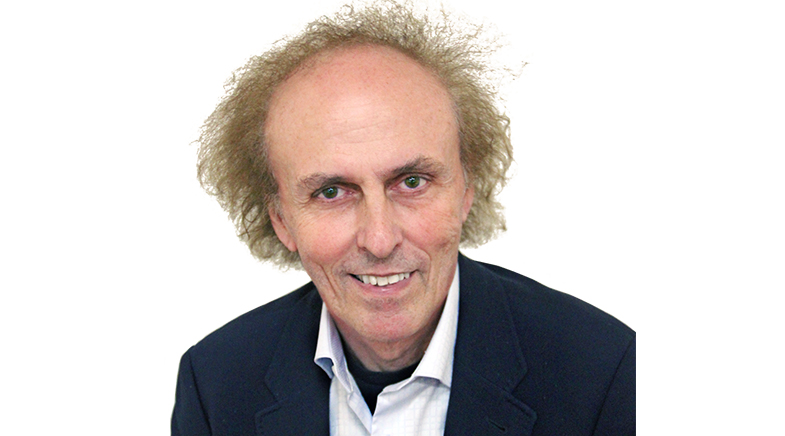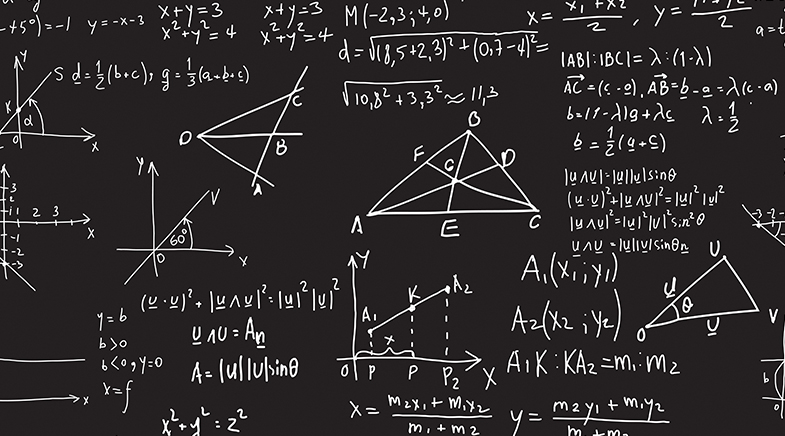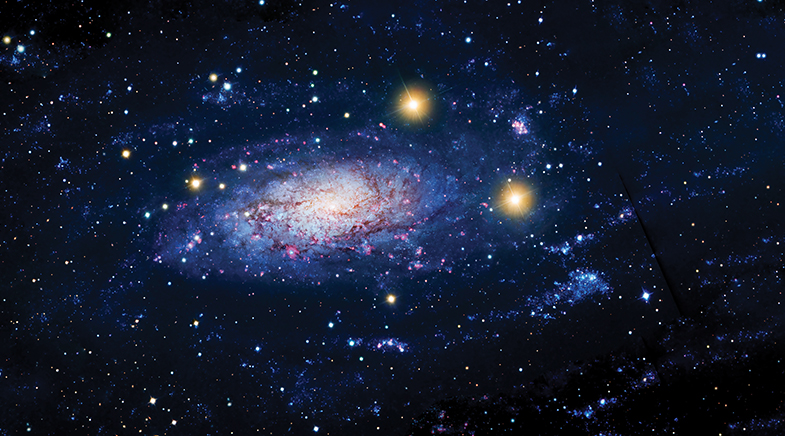Strength in numbers
-
- from Shaastra :: vol 02 issue 01 :: Jan - Feb 2023

Paulos links politics, puzzles and probability — and lies, logic and religion — to tell us how we may become better citizens by acting on the connections.
Both mathematics and humor..." begins an early sentence in John Allen Paulos's book. Stopping there for a moment, I wondered if he was about to draw a parallel between these two particular facets of the human experience. What on earth could that parallel be? Both, Paulos explains, are "economical and explicit".
"Thus, the beauty of a mathematical proof depends to a certain extent on its elegance and brevity... Similarly, a joke loses its humor if it is awkwardly told, is explained in redundant detail, or depends on strained analogies."

Oh yes, indeed. The memorable jokes are the short, pointed punch lines that leave people falling over themselves laughing. In the same way, the memorable mathematical proofs are concise and clear-eyed and can leave mathematicians marvelling at their ingenuity. Euclid's proof of the infinity of primes, for instance, is a masterpiece of the breed. The most beautiful proofs convey their essence to even mathematical dilettantes like me.
Why is Paulos comparing humour and mathematics? He's... showing just how ubiquitous mathematics is and how much we lose by being deaf to that truth.
Yet, exactly why is Paulos comparing humour and mathematics? He's doing what I suspect has become a lifelong pursuit: showing just how ubiquitous mathematics is and how much we lose by being deaf to that truth. He's doing so by relating mathematics to so much that makes us human. So, there's humour, of course — is there anything quite as human? But also lies and logic and religion, also politics and puzzles and probability. If you're hard-pressed to see the connections, do read the book: that's why Paulos wrote it, precisely to show that the connections exist; that by recognising and acting on them, we may become better citizens – by understanding the facts and figures that swirl about us, and being better informed about public policy decisions.
Does that sound high-minded? Perish the thought! High-minded this book is not, and I mean that as a compliment. Admittedly, some sections need a little more thought than others, perhaps occasionally a serving of mathematical dexterity. But open your mind to those, too, and this book brings plenty of rewards.
Happiness, too, maybe. In a chapter titled "Does the Declaration of Independence Guarantee Happiness?", Paulos details an intriguing manoeuvre inspired by a card trick devised by the mathematician Martin Kruskal. Pick any word near the start of the American Declaration of Independence. Count the number of letters in it (say, four), move four words forward, count the number of letters in the word you land on (say, six), move six words forward, repeat till you reach the end.
HAPPY TO ENACT
It seems like a fairly random exercise, doesn't it? Why then is it that the last word you will land on, every time, is the last word of the Declaration, "Happiness"? Did America's founding fathers craft this passage in a particular way so that this would happen?
Well, I once tried the same game with the Preamble to the Indian Constitution. In an article, I wrote of my desire to "persuade you, in a mathematical way, that [the Constitution] was indeed enacted for us all. I mean exactly that: enacted." Because this exercise takes you, unerringly, to the word "ENACT" near the end of the Preamble. So, did our founding fathers craft the Preamble this way? Is this their subtle hint to us Indians to take pride in our Constitution?
The answer is no, and that applies to happiness in the Declaration, too. Instead, this is the intriguing mathematical phenomenon Kruskal discovered. There's a perfectly logical explanation, not even especially hard to follow, for why it works. Who would have thought, mathematics in the Preamble?
And who would have thought, mathematics in the Bible? Elsewhere, Paulos introduces us to the notion of ELS — equidistant letter sequences. Unbeknownst to me, there is apparently a whole subculture devoted to the endeavour of seeking hidden messages in the Bible using ELS, and then ascribing some profound meaning to them. Somewhat reminiscent of the Kruskal process, it happens like this: start at some letter in the Bible. Choose a number at random. Jump that many letters ahead, note down the letter you've landed on, keep jumping that many letters and noting. Does the sequence of equidistant letters spell out something significant?
You'd think not. But a 1994 paper in a journal of statistics did this exercise in the Hebrew text of the biblical Book of Genesis and found "names of rabbis and prophets, specific dates, and historical events". The authors "calculated the probability of their occurrence (by chance) to be vanishingly small, leading some to assert the codes' divine origin."
PATTERNS OF ALL KINDS
Certainly it is a surprise that this game with letters produces names and dates. But note how easy it is to extrapolate from the idea of a tiny chance directly to the call to divine origins. Yet as Paulos's chapter heading reminds us, the really astonishing thing would be if, in playing this game, "one didn't find hidden messages in the Bible". That's a valuable lesson, and for far more than just scanning the Bible this way. The really astonishing thing about life itself would be if we didn't run into coincidence, didn't find patterns of various kinds.
And what's that, I hope you are dying to ask, about lies? Still another section in the book, for one example, is "Sex, Lies, and Statistics: Some Musings". Paulos observes that sex surveys are often "less insightful than a good novel or such idle musing" — for the results they report are more than likely "seriously flawed". Why is this? People are hardly likely to be truthful about their sexual preferences and behaviours, especially to a stranger asking poll questions. This explains why, for example, surveys will report that heterosexual men claim many more sexual partners than heterosexual women do.
And yet, if there is a broad blanket of bland lies that blight such surveys, there are, Paulos tells us, ways to at least try to extract the truth. Mathematical ways, of course. Consider what Paulos suggests if you seek to discover what fraction of a population has cheated on their spouses. Asking the question point blank of hundreds of people chosen at random is unlikely to get you an accurate answer: why would anyone open up about this to a stranger? So, instead, you ask the respondent to privately flip a coin. If it turns up heads, they should answer "yes" regardless of the truth. But if tails, they should answer honestly. Since they know you have no idea how their coin has landed, it's likely they will be honest. From the overall result, it's easy to tease out a cheating number that is likely to be close to the truth. Or at least, closer than the point-blank question will return.
POWER OF MATHEMATICS
The book is filled with fascinating insights like this, with anecdotes and analysis and advice. It is really a collection of Paulos's columns on ABCnews.com and elsewhere over many years, possibly a 'Greatest Hits' compilation. Like many such compilations, it has a certain uneven quality, as if Paulos is jumping from subject to subject. Which he is, of course. Some of the material is clearly dated, too, referring to news or events from years ago. You might even wonder, why didn't Paulos smooth all this out, rewrite passages here and there?
And yet at some point in the book, you start to realise that this unevenness serves to underline Paulos's point. The mathematics that's all around us, after all, doesn't come to us smoothly, in neatly formed themes or topics or packages. It's not separated into ascending levels of difficulty. It's not necessarily chronological, certainly not alphabetical, never orderly.

But if you care to look, if you're willing to think and savour, the mathematics is everywhere, period.
Reading this book, then, reminds me of long rides by train across India. As you travel, the landscape keeps changing and you never can predict what experience is next. But there comes a point when you understand that that is itself a major reason you took the train ride at all: precisely because you have no idea what's next.
People are hardly likely to be truthful about their sexual preferences and behaviours, especially to a stranger asking poll questions.
In much the same way, it seems to me, the very unevenness and unpredictability of this book makes Paulos's case. You don't know what's next, and that is itself the spirit of romance the book serves up. In a very real sense, this is the romance of mathematics itself. Fall in love, all over again.
Once a computer scientist, Dilip D'Souza now writes on mathematics, among other things.
Have a
story idea?
Tell us.
Do you have a recent research paper or an idea for a science/technology-themed article that you'd like to tell us about?
GET IN TOUCH














